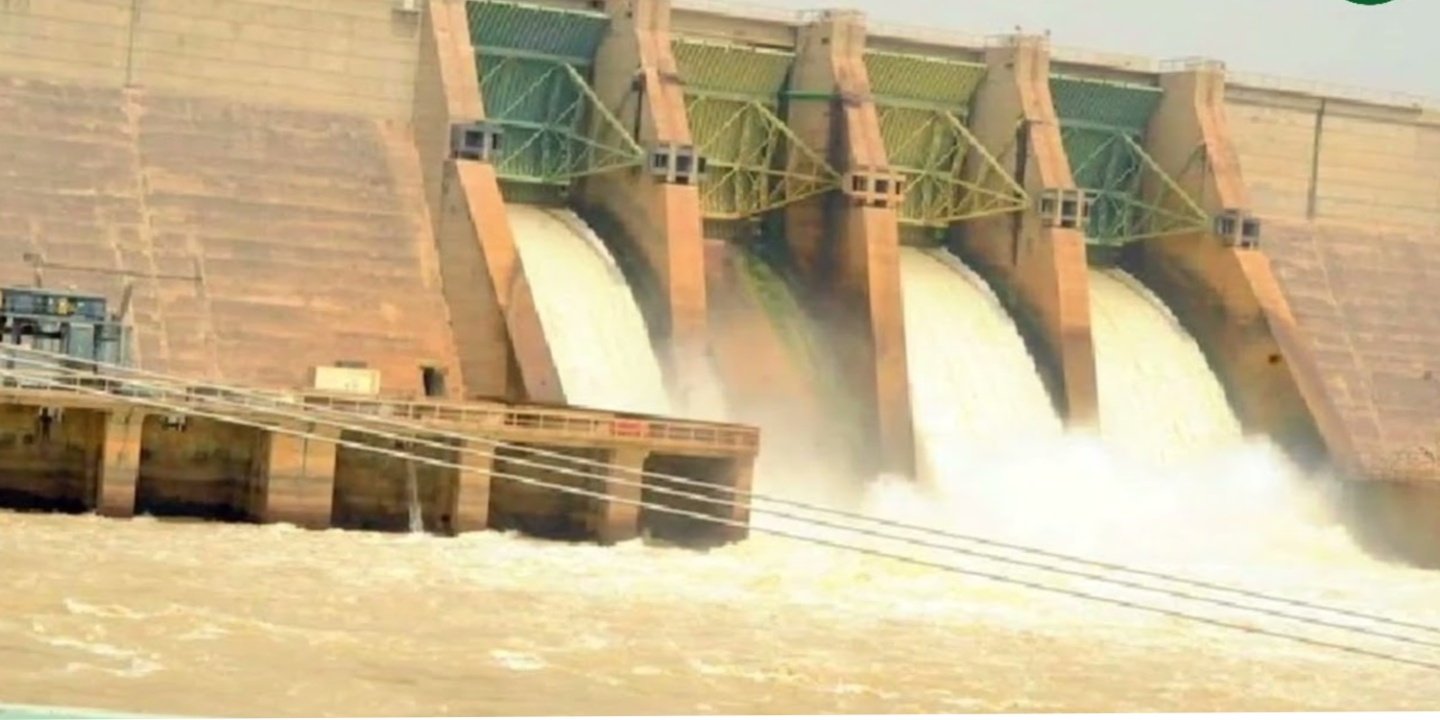International
Lagdom Dam: Nigeria gears up for looming flood disaster

A few days ago, the National Emergency Management Agency, NEMA, alerted Nigerians of impending flooding along the River Benue Basin.
According to the alert, the Cameroonian Government has plans to “open the flood gates of the Lagdo Dam on the Benue River”.
Recall that a Memorandum of Understanding, MoU, was signed in 2016 between Nigeria and Cameroon regarding the release of water from the dam, in which Cameroon will always inform Nigeria before it opens the gates to the dam.
In a letter addressed to Nigeria’s Ministry of Foreign Affairs, the Cameroonian government warned of its intention to release water from the Lagdo dam and asked the agency to take precautionary measures.
Over the years, the massive flooding in many states across the country was attributed to the release of water from the Lagdo Dam.
It was reported that the dam located along River Benue in the Republic of Cameroon has a history of over-flooding some Nigerian states along its navigation ways. These states include Benue, Adamawa, Taraba, Nasarawa, Kogi, Anambra, Enugu, Edo, Delta, Rivers and Bayelsa.
However, in 2019, the dam was opened without prior notification, resulting in flooding in Adamawa, Taraba, Benue, Kogi, and the Niger Delta regions during October and November of that year. There was also flood devastation in 2022, leading to the loss of lives and properties worth billions of naira.
NEMA had recently disclosed in its report that the 2022 flood disaster claimed no fewer than 665 lives, while 2,437,411 and 4,476,867 persons were displaced and affected, respectively.
The agency also announced, “As of August 9, data collated regarding 2023 flooding so far showed that 10 States have been affected, while 33,983 and 7,353 persons were affected and displaced, respectively.
“The breakdown also showed that 75 persons were injured while five deaths were recorded, including 1,679 damaged houses and 866 hectares of damaged farmlands.”
Reacting to the development, NEMA said the notice is not new, noting that it had since informed state governors of impending floods, including that from the Lagdo Dam.
The agency’s spokesperson, Manzo Ezekiel said it was time for the affected state governors to take action and secure lives and properties in collaboration with NEMA.
Ezekiel assured Nigerians that NEMA was working with critical stakeholders, including federal, state and local governments to ensure that the release did not cause negative impacts, asking Nigerians not to fear the opening of the Lagdo Dam.
“Information available from the flow level of River Benue at Nigeria Hydrological Services Agency (NIHSA) gauging station in Makurdi stood at 8.97 meters as of August 25, compared to 8.80 meters on the same date in 2022.
“In contrast, NIHSA has also provided that the flow level of the River Niger system, specifically at Niamey, Niger Republic, remains stable at a normal level of 4.30 meters.
“Similarly, inland dams, including Kainji, Jebba, and Shiroro, reported consistent flow regimes.
“With regards to the hydrological station downstream, the confluence of the Niger and Benue rivers in Lokoja, Kogi are currently within normal limits,” he said.
However, the Lagos State Emergency Management Authority, LASEMA, has restated the state government’s preparedness to tackle any possible emergency from the impending flood.
The Permanent Secretary of LASEMA, Dr Femi Oke-Osanyintolu, disclosed that the state government had provided LASEMA with 144 units of facilities that could accommodate 5,000 Internally Displaced Persons, IDPs, in the event of any emergency.
He noted that Lagos was well prepared, as LASEMA has changed from management to holistic emergency management.
“We have carried out risk analyses, resource mappings, and opened directories in each council to know the vulnerable people in emergencies. All these measures are geared towards ensuring swift, prompt, and effective responses,” he said.
In the same vein, the Delta State government has also expressed its preparedness.
It said it is taking proactive steps to mitigate the effect of flooding in the state, saying it will not hesitate to set up Internally Displaced Persons, IDPs, camps in the event of severe flooding.
“We are already opening drainages and demolishing illegal structures blocking the waterways,” a government official said.
On his part, the president of the Nigeria Society of Engineers, Tasiu Gidari-Wudil, also advised the government to construct flood control dams along the Rivers Niger and Benue to avert flooding that might occur from the opening of the Lagdo Dam.
Gidari-Wudil, in a press conference in Abuja on Monday, called for the dredging of major rivers to reduce siltation and sedimentation.
He lamented that the recommendations by the committees set up by the government after the 2012 and 2022 flood disasters had not been implemented.
Meanwhile, the Presidential Committee, set up by President Bola Tinubu, says it will implement various policies and rescue missions to mitigate the flood’s impacts from Lagdo Dam.
The Minister of Humanitarian Affairs and Poverty Alleviation, Dr Betta Edu, who spoke at a briefing in Abuja at the instance of the committee, urged the Governors’ Forum to step up actions by ensuring the immediate evacuation of Nigerians from flood-prone communities to safer destinations.
She stated that the President had directed that all relevant ministries meet to find a solution to the flooding issue.
In an interview, an environmental remediation expert, Dr Moses Paul stated that relevant stakeholders should prioritise the safety and well-being of the affected population to mitigate the damage that the flood may cause.
Paul, also the Convener of Free Nigeria Movement/YELL OUT Nigeria, believes that the President and state governors should collaborate with relevant stakeholders and allocate resources effectively to manage the situation to prevent further harm.
According to him, the government should also improve early warning systems for floods, which he said could involve the installation of weather monitoring stations, flood forecasting models, and communication networks to provide timely alerts to vulnerable communities.
The environmental expert also urged relevant stakeholders to ensure that psychosocial support services, including mental health support and counselling services, would be available for those affected by the flood.
“The number one priority of government and leadership anywhere in the world is the focus in ensuring a rapid and effective response, particularly anything that will bring to safety the life and property first and foremost of her citizens.
“Therefore, the major concerns and advice for the Nigerian President and state governors in such a scenario as we face today would include establishing effective communication channels, such as mobile alerts or community networks, to disseminate early warning messages and information to at-risk communities to help ensure timely preparedness and evacuation.
“Ensuring residents’ prompt and safe evacuation in the affected areas is crucial. This includes preparing and coordinating relief efforts to provide food, clean water, medical aid, and other essential supplies to flood victims.
“The long-term should include planning for rehabilitation and reconstruction to aid affected communities in their recovery.
“In addition, it is important to ensure that psychosocial support services are available for those affected by the flood, as many individuals may experience trauma, loss, or displacement. Mental health support and counselling services should be activated to help individuals cope with the emotional and psychological impact.
“Encouraging collaboration among multiple stakeholders, including government agencies, NGOs, and local communities, is vital for effective disaster response. Coordinated efforts and the pooling of resources will enhance the overall response capacity.
“It is equally important for the Nigerian President and state governors, particularly those bordering the River Benue, to prioritise the safety and welfare of the affected population, work in collaboration with relevant stakeholders, and allocate resources effectively to manage the situation and prevent further harm by integrating climate change projections into long-term flood management strategies for riverine areas in the country.
“These can be achieved if the government can consider the following steps in addition:
“The government should assess the vulnerability of riverine areas to floods and the potential impacts of climate change. This assessment should consider factors such as population density, land use patterns, infrastructure, and socio-economic conditions.
“The government should incorporate climate change scenarios into its flood risk assessments, including projections of increased frequency and intensity of extreme weather events. This would help in understanding the potential future flood risks in riverine areas.
“Moreover, it is wise for the government to enforce strict regulations on land-use planning in flood-prone areas. This can involve restricting construction in high-risk zones and promoting sustainable land-use practices that minimise the exposure and vulnerability of communities to floods.
“Another aspect is to prioritise the construction of climate-resilient infrastructure in riverine areas. This can include building flood-resistant roads, bridges, and buildings and implementing nature-based solutions such as restoring wetlands and constructing floodplains.
“Aside from the above, the government should engage with local communities to raise awareness about climate change impacts and flood risks. This can include organising workshops, training programs, and public campaigns to educate communities on flood preparedness, early warning systems, and evacuation plans.
“In conclusion, the Nigerian government should collaborate with international organisations and partners to access technical expertise, funding, and knowledge-sharing platforms. This collaboration can help develop and implement effective flood management strategies based on climate change projections.
“By integrating climate change projections into long-term flood management strategies, the Nigerian government can enhance riverine areas’ resilience and minimise future floods’ impacts on communities and infrastructure,” he said.
International
JUST IN: Trump Sacks US Ambassador To Nigeria, Others

The Trump administration has recalled the United States Ambassador to Nigeria, Richard M. Mills Jr., as part of a broader shake-up involving nearly 30 career diplomats serving in ambassadorial and senior embassy posts around the world.
Mills, who assumed his post in Nigeria in July 2024 during the Biden administration, is among the affected envoys who received notices last week that their tenures will end in January 2026. The move aligns with efforts to ensure U.S. diplomatic representatives fully support President Donald Trump’s “America First” foreign policy priorities.
Africa has been the most impacted region, with ambassadors recalled from 13 countries: Burundi, Cameroon, Cape Verde, Gabon, Côte d’Ivoire, Madagascar, Mauritius, Niger, Nigeria, Rwanda, Senegal, Somalia, and Uganda. Other affected regions include Asia (six countries, including the Philippines and Vietnam), Europe (four countries), the Middle East (two countries), and additional posts in South Asia and the Western Hemisphere.
Many of these diplomats were appointed under the previous Biden administration and had initially survived an earlier wave of changes that primarily targeted political appointees. Ambassadors serve at the pleasure of the president and typically hold posts for three to four years, though the administration described the recalls as a “standard process” for any new presidency.
A State Department spokesperson defended the decision, stating: “An ambassador is a personal representative of the president, and it is the president’s right to ensure that he has individuals in these countries who advance the America First agenda.”
The recalls, first reported by Politico, have raised concerns among some lawmakers and the American Foreign Service Association, the union representing U.S. diplomats. The affected career diplomats will return to Washington for potential reassignment but will no longer serve as chiefs of mission in their current postings.
International
UPDATE: Burkina Faso Releases 11 Detained Nigerian Air Force Personnel and Aircraft Following High-Level Talks

Burkina Faso has released 11 Nigerian Air Force personnel and their C-130 aircraft, ending a nearly two-week diplomatic standoff triggered by the plane’s emergency landing in the country.
The release was confirmed shortly after Nigeria’s Minister of Foreign Affairs, Ambassador Yusuf Maitama Tuggar, concluded a meeting with Burkina Faso’s President, Captain Ibrahim Traoré, on Wednesday in Ouagadougou.
Tuggar, acting as President Bola Ahmed Tinubu’s special envoy, delivered a message of solidarity and fraternity while addressing the incident involving the aircraft, which made a precautionary landing in Bobo-Dioulasso on December 8 due to technical issues en route to Portugal.
A statement from Alkasim Abdulkadir, spokesperson for Tuggar, described the resolution as amicable, noting that both nations resolved concerns over the Nigerian Air Force pilots and crew through constructive dialogue.
The Ministry of Foreign Affairs later confirmed the release of both the personnel and the aircraft, emphasizing sustained diplomatic engagement at the highest levels.
The incident had initially raised tensions, with Burkina Faso citing procedural irregularities in airspace authorization. Nigeria expressed regret over the matter while reaffirming respect for Burkina Faso’s sovereignty.
Officials on both sides highlighted the spirit of fraternity, with Tuggar praising the treatment accorded to the crew during their stay. Discussions also touched on broader cooperation in security and counter-terrorism.
The swift resolution underscores ongoing efforts to maintain neighborly relations amid regional challenges, with the personnel expected to return home imminently.
International
Nigeria’s Foreign Minister Tuggar Delivers President Tinubu’s Message of Solidarity to Burkina Faso’s Traoré Amid Diplomatic Resolution

In a high-level diplomatic engagement, Nigeria’s Minister of Foreign Affairs, Ambassador Yusuf Maitama Tuggar, met with Burkina Faso’s President, Captain Ibrahim Traoré, on Wednesday to deliver a personal message of solidarity and fraternity from President Bola Ahmed Tinubu.
The meeting, held in the Burkinabè capital, focused on strengthening bilateral ties and addressing shared regional challenges, particularly in security and counter-terrorism efforts.
Sources confirm that the visit paved the way for the swift release of 11 Nigerian Air Force personnel and their aircraft, which had been detained following an emergency landing earlier this month.
Tuggar emphasized the longstanding historical bonds between the two nations, stating after the audience: “We exchanged views on cooperation in several sectors, including the fight against terrorism. Nigeria remains committed to sustained dialogue and enhanced regional solidarity to tackle common threats.
“A key point of discussion was the recent incident involving a Nigerian C-130 aircraft that made a precautionary landing in Bobo-Dioulasso due to technical issues.
Tuggar acknowledged procedural irregularities in the airspace authorization process, expressing Nigeria’s regret and reaffirming respect for Burkina Faso’s sovereignty and international aviation norms.
The minister also distanced the Nigerian government from controversial remarks by a domestic political figure alleging mistreatment of the detained personnel, declaring: “We clearly dissociate ourselves from those comments and express our sincere regrets to the government of Burkina Faso.
“Tuggar praised President Traoré’s administration for the “spirit of fraternity” shown toward the Nigerian crew during their stay, noting Burkina Faso’s recent successes in counter-terrorism operations.
The resolution underscores Nigeria’s preference for diplomacy in resolving regional misunderstandings, with officials highlighting ongoing collaboration despite broader sub-regional tensions.
The released personnel are expected to return home shortly, marking a positive step in Nigeria-Burkina Faso relations.
-

 Entertainment3 days ago
Entertainment3 days agoGbenga Bada Urges NIJ Students: Embrace Passion, Professionalism in Entertainment Reporting
-

 Sports3 days ago
Sports3 days agoAFCON to be held every four years after 2028 – Motsepe
-

 Crime1 day ago
Crime1 day agoBREAKING: Nigeria Secures Release of Last 130 Abducted Pupils in Niger State; None Remain in Bandit Captivity
-

 News3 days ago
News3 days agoLagos Labour Union Praises Gov Sanwo-Olu for 100% Year-End Bonus and Car Gifts to Workers
-

 News3 days ago
News3 days agoUS stops Nigerians, others from applying for green card, citizenship
-

 News19 hours ago
News19 hours agoTinubu Hails DSS DG Ajayi for Championing Press Freedom in IPI Award Recognition
-

 Entertainment3 days ago
Entertainment3 days agoGrammys to honour Fela with special merit award
-

 Sports22 hours ago
Sports22 hours agoAFCON 2025: Davido bets N36million on Nigeria vs Tanzania



















